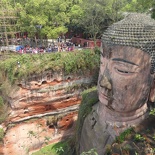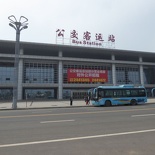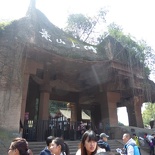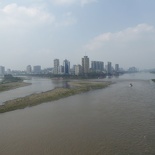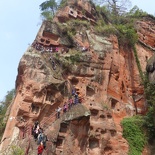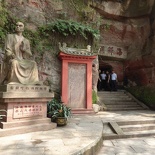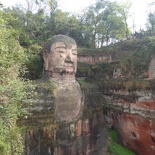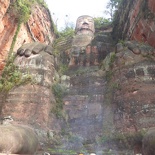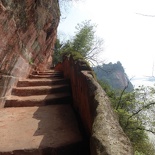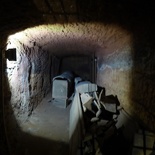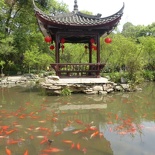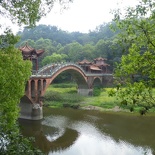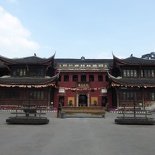The Leshan giant Buddha (pronounced Lèshān Dàfó in Mandrin) is a 71m tall natural stone statue carved out of a cliff face during the Tang Dynasty. It is the largest stone Buddha in the world facing Mount Emei and the confluence of the Minjiang, Dadu and Qingyi rivers in the southern part of Sichuan province in China.
Getting there
Getting to the UNESCO World Heritage Site (since 1996) begins with a high speed train to the LeShan station, near the exit of the train station are a couple of bus stop stands. Here, you can catch a 40 minute bus ride (service no. 3) direct to the attraction itself. A one way trip costs 1 yuan, you drop off the cash into the transparent coin boxes in the bus with a red lip. There will be several private car operators (black cabs) offering a quick direct ride at 4-10 yuan per person with instant departure, about 10mins faster than the 40mins public bus. They are very pushy and persistent with their selling tactics. If you are not strapped for time and don’t mind the risk of potentially being robbed, I suggest avoiding these unregistered taxis and use the bus service 3 instead.
The service 3 bus route takes about 40- 50mins depending on traffic density, passing through central LeShan city area (a rather busy area) before crossing a road bridge over one of the Yangtze tributaries (Minjiang river), signalling you are nearing the attraction. The attraction entrance is by the road with the bus stop adjacent to it, identified by large stone pillars overhanging the main turnstile entrance. You have two ticket options, a 50 yuan option for just the Buddha itself or a 90 yuan one including access to lesser attractions such as the Mahao cave tombs and Wuyou hill top temple and bridge. If you are just planning on just visiting the cliff side Buddha, you are good for a 2 hour stay and crowds will be much lower past 3pm (the park closes at 6pm).
At the ticketing entrance, you may get swarmed by freelance tour guides asking whether will you like a personalized guide (only in Mandarin) for your trip, with benefits of beating the ticking queue lines. These tour guides cost 5 yuan per person, who will introduce to you sights on the way up to the LeShan Buddha where you are on your own thereafter. I won’t recommend going for the guides as it’s not really a good quality tour and it’s available only in Mandarin, if you wish, you can simply just tag along beside a group and they will explain all what you need to know and save your money.
The attractions
A short continuous stair climb from the entrance brings you to the hill top of the attraction and the highest point of the LeShan Buddha hill top, various wall cravings on the hill side offers spectacular views of Leshan city and Haitang Park in the distance, making the climb a less tedious affair. At the top, you can visit the Dafo and Lingyun temples, as well as the cave residence of Monk Haishi. You can view the giant Buddha from the top and it’s sides, and take the Nine turn cliff road right down to the front of the Buddha’s feet at the bottom of the cliff just by the Minjiang river.
Legend has it that the idea of a giant Buddha came from a Monk by the name of Haitong, who kick-started the project in 713 AD using the money he collected begging alms. He gathered a team of devotees to crave the Buddha hopefully to calm the turbulent waters plaguing the region, which painstakingly took 90 years to complete. Following the Giant Buddha comes the Lingyun cliff road, a 500m stone path running alongside the Leshan Buddha cliff face overhanging the Minjiang river.
Secondary minor attractions includes the Sanctuary of Buddhas, a giant Buddha cave, the Wuyou temple and Mahao cave tombs. With the last two being payable extras on the 90 yuan ticket. The Buddha cave requires another separate 60 yuan entrance fee. The cave tombs is a small minor attraction showcasing burial grounds in dug-in hill caves. The Wuyou temple is a worthy visit. Getting there involves walking through an old Tang dynasty-era village and crossing the beautiful Haoshang Bridge, offering nice views the countryside river. The Wuyou temple is one of the less-visited areas, and quite devoid of tourists. Getting up there involves a 15min hill climb through a forest offering awesome views of the Minjiang rivers.
A typical full visit like mine will set you back about 5-6 hours. Much of the attractions after a while becomes largely repetitively similar. I will personally recommend making the Giant Buddha your primary visitation objective and you won’t miss much not visiting on the secondary complimentary attractions.

